I want to measure the RMS value of voltage of half wave and full wave rectified sinusoidal wave using CRO itself. How do I go about it?
-
Tell us more about your scope. With mine I just set cursors at the start and end of the waveform and ask what is the rms. I'm guessing you need to calculate it as otherwise you wouldn't be asking. What exactly is your waveform and what do you know about it? – Warren Hill Nov 07 '17 at 18:12
-
1Have you seen [Half-wave rectifier and RMS value](https://electronics.stackexchange.com/q/72130/36731)? – Andrew Morton Nov 07 '17 at 18:13
-
0_0 But CRO is not a calculator. It can indicate on scale, what is the peak value of the rectified wave. Just divide it by 2 to get RMS value(HW) otherwise root(2) (FW). – Mitu Raj Nov 07 '17 at 18:14
-
Updated the question, I want to find the RMS value for both half and full wave rectified voltage. – akshayk07 Nov 07 '17 at 18:17
-
@WarrenHill it's not a DSO, if that's what you are asking. – akshayk07 Nov 07 '17 at 18:25
-
@AndrewMorton It's not really related as I am asking how we can measure it rather than how to calculate it. – akshayk07 Nov 07 '17 at 18:30
3 Answers
In the general case of some arbitrary waveform, a CRO is not the right tool for measuring RMS voltage. However, in your case you have a waveshape with fixed and known relationship between RMS and something easily measurable, like the peak voltage.
For a sine, the peak is RMS x sqrt(2). Full-wave rectification doesn't change that, just that there is now a lower AC component and a non-zero DC component.
So, look at the height of the peaks, find what voltage that relates to, then divide that by sqrt(2) to get the RMS voltage.
- 310,974
- 36
- 428
- 915
-
To find the DC voltage, we can use the DC offset button. I suppose there isn't any such way? – akshayk07 Nov 07 '17 at 18:21
Modern day oscilloscope contains a measure button (the first grey button of the image)clicking on it will fetch you all the value of all the important parameters some of which are time period ,v(peak to peak), v(rms ) ,v(max ) and so on.
- 196
- 8
-
I think what you are talking about is a digital storage oscilloscope, but I wanted to know about a cathode ray oscilloscope which does not have such features. – akshayk07 Nov 07 '17 at 18:19
-
Then in that case i dont think it is possible to calculate the value of v(rms) just by knowing how the graph looks like the only possible way is in case you have its equation of the waveform then you can find it mathematically. – Pink Nov 07 '17 at 18:25
-
@Udmen You don't need the exact formula but you can break the waveform but you can break the waveform into sections, integrate each of the \$ v(t)^2 \$ individually and calculate from there. When I first started this was the approach we took but modern scopes do make the job much easier – Warren Hill Nov 07 '17 at 19:21
-
Yes you can do that provided your waveform is not much clumsy or zig-zag kind of graph.In case you land on a standard waveform such as square or a sinusoidal the calculation are very simple but more the graph gets weird,the more horrible the calculations becomes!! – Pink Nov 08 '17 at 02:57
If you know the shape of the waveform you can calculate this by direct application of the formula.
$$v_{rms} = \sqrt{\dfrac{1}{T} \cdot \int_0^T v(t)^2 \text{ d}t}$$
As pointed out by Olin with full wave rectification the rms value does not change as the absolute amplitude of the voltage is the same at all times it is just always positive.
For half wave rectified then you have a half cycle of sine wave followed by a half cycle of zero volts.
So by direct application of the formula
$$\begin{align}\ V_{rms} &= \sqrt{\dfrac{1}{2 \pi} \int_0^\pi \left( V_{pk}\cdot \sin(\theta) \right)^2 \text{ d}\theta} \\ &= Vpk \cdot \sqrt{\dfrac{1}{2 \pi} \int_0^\pi \sin(\theta)^2 \text{ d}\theta} \\ &= Vpk \cdot \sqrt{\dfrac{1}{2 \pi} \left[ \dfrac{\theta}{2} - \dfrac{\sin(2 \theta)}{4} \right]_{\theta = 0}^\pi} \\ &= Vpk \cdot \sqrt{\dfrac{1}{2 \pi} \left( \left[ \dfrac{\pi}{2} - \dfrac{\sin(2 \pi)}{4} \right] - \left[ \dfrac{0}{2} - \dfrac{\sin(0)}{4} \right] \right)} \\ &= \dfrac{V_{pk}}{2} \end{align} $$
My DSO applies the direct formula the only other way to get rms is by calculation.
Edit: A good DSO in an expensive purchase but many reasonable priced hand held meters can measure true rms by direct calculation but they typically work at much lower bandwidths say a few kHz while my scope is good for a few hundred MHz.
- 4,780
- 20
- 32